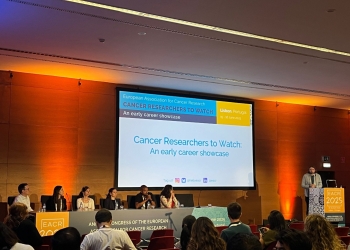The EACR’s ‘Highlights in Cancer Research’ is a regular summary of the most interesting and impactful recent papers in cancer research, curated by the Board of the European Association for Cancer Research (EACR).
The list below appears in no particular order, and the summary information has been provided by the authors unless otherwise indicated.
Karimi, E., Yu, M.W., Maritan, S.M., Peruset, L. J. M. et al. Nature. 614: 555–563 (2023).
doi: 10.1038/s41586-022-05680-3.
 Summary of the findings
Summary of the findings
Glioma and brain metastases are invariably fatal tumours of the central nervous system that respond poorly to currently available treatment options. Poor treatment response is influenced, in part, by the unique nature of the local microenvironment, including the diverse populations of immune cells found near and within brain tumours. However, little is known about the complex spatial organization and cell-cell relationships of the brain tumour microenvironment and how it can be leveraged for therapeutic discovery.
In this work, highly multiplexed imaging mass cytometry (IMC) was used to profile 139 primary gliomas and 46 brain metastases from patients at the single-cell level with spatial resolution. More than 1.1 million cells were profiled and categorized into 20 distinct cell populations, which revealed unique cellular landscapes between primary and secondary brain tumours. Moreover, spatial analyses revealed cell-cell interactions and cellular neighbourhoods that were common across disease states and associated with clinical outcomes. Cellular neighbourhoods that were present in brain metastases from different primary sites, as well as macrophage-enriched cellular neighbourhoods associated with prolonged survival of patients with glioblastoma, were described. Deeper spatial interrogation of macrophages in glioblastoma samples uncovered a population of monocyte-derived macrophages expressing myeloperoxidase (MPO) that were associated with an unexpected survival benefit.

Future impact
This work provides a high-dimensional, spatially resolved map of the tumour microenvironment within both primary and secondary brain tumours, serving as a critical resource for the cancer research community. Moreover, the discovery of MPO+ monocyte-derived macrophages in the brain tumour microenvironment and their association with improved outcomes warrants further investigation into the potential therapeutic roles of this cell type. Overall, this work adds to the growing evidence that the spatial architecture of the tumour microenvironment is a crucial component of the underlying tumour biology and can aid in therapeutic discovery.
 Summary of the findings
Summary of the findings









